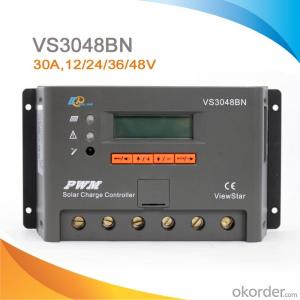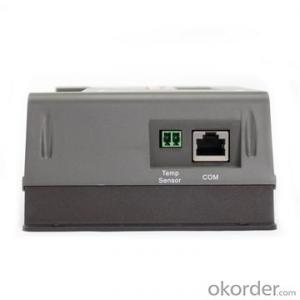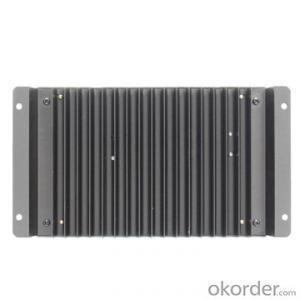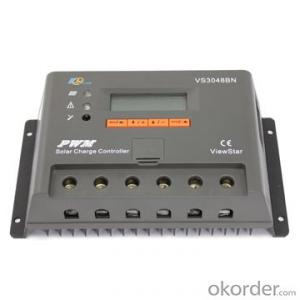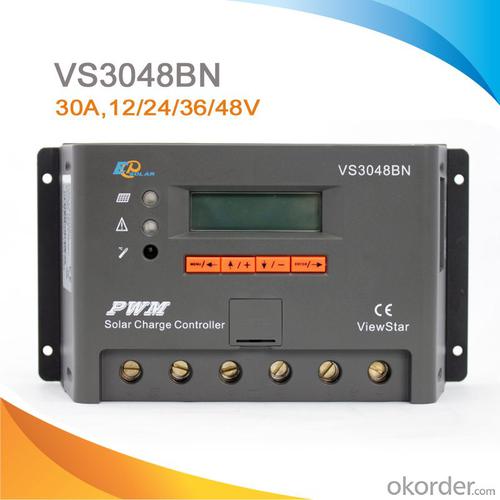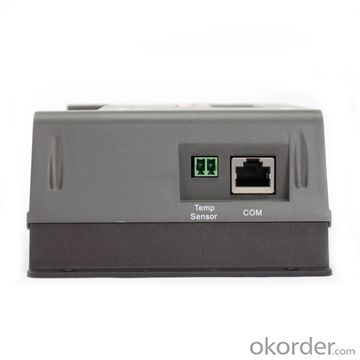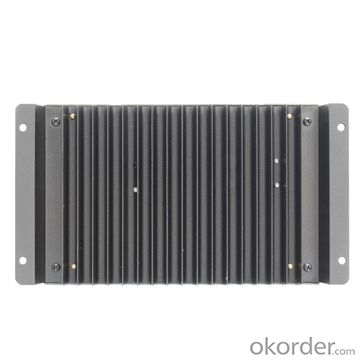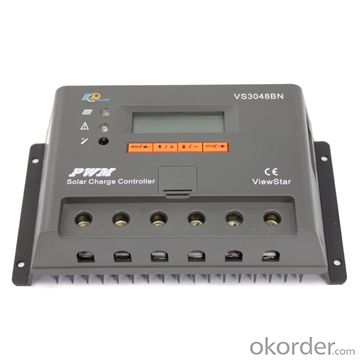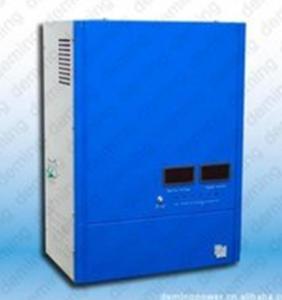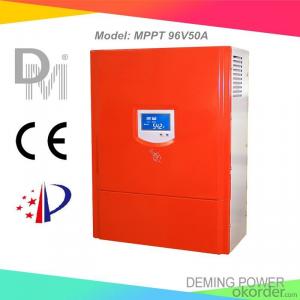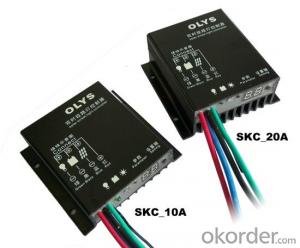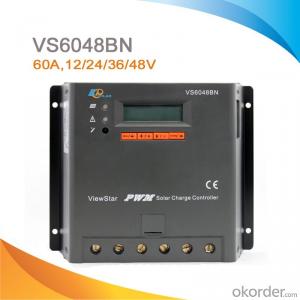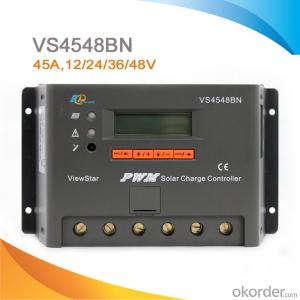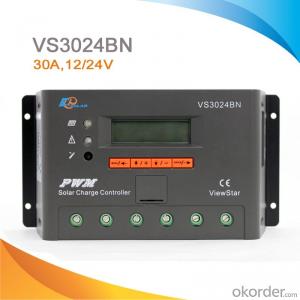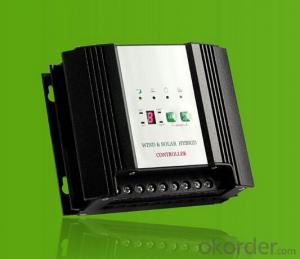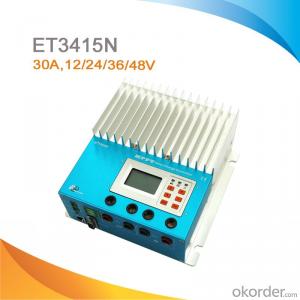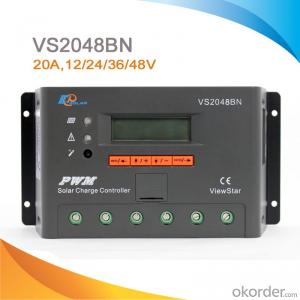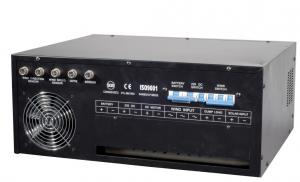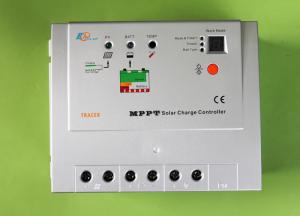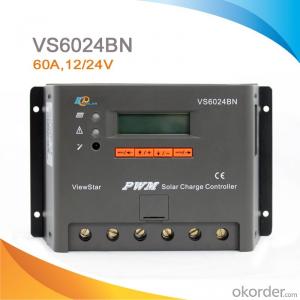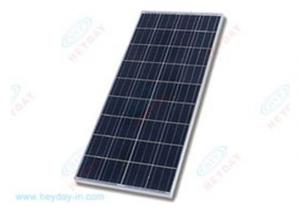LCD Display PWM MPPT Solar System Charge Controller/Regulator 30A 12/24/36/48V, VS3048BN
- Loading Port:
- Tianjin
- Payment Terms:
- TT or LC
- Min Order Qty:
- -
- Supply Capability:
- 10000 pc/month
OKorder Service Pledge
OKorder Financial Service
You Might Also Like
ViewStar series solar controller is our new generation controller for off-grid solar system, such as street light, solar home system or small power station etc.
Features:
·Excellent EMC design
·32 bit MCU with high speed
·High efficient Series PWM charging
·Four battery type options: Sealed, Gel, Flooded, and USER
·Intelligent lighting and timer control for solar lighting system
·12 bit A/D high-precision sampling to ensure accuracy
·Use MOSFET as electronic switch
·Full control parameters setting and modification, diversified load control mode
·Humanized design of browser interface, undertake every operating conveniently
·Temperature compensation
·Adopt graphics dot-matrix LCD screen and HMI (human-machine interface) with 4 buttons,integrated menu displaying and operation
·Energy statistics function
·RS485 ports with MODBUS communication protocol
·Optional PC monitoring software and remote meter for real-time monitoring and battery management parameter setting
·Field upgradable firmware
Electronic Protections:
·PV short circuit protection
·PV reverse polarity protection
·Battery overcharge protection
·Battery over discharge protection
·Battery reverse polarity protection
·Load overload protection
·Load short circuit protection
·Overheating protection
Specification:
Nominal system voltage | 12/24/36/48V auto work | |||
Rated battery current | 20A | 30A | 45A | 60A |
Rated load current | 20A | 30A | 45A | 60A |
Max. battery voltage | 64V | |||
Equalize charging voltage | Sealed: 14.6V, Flooded: 14.8V, User-defined: 9~17V | |||
Boost charging voltage | Gel: 14.2V, Sealed: 14.6V, Flooded: 14.8V, User-defined: 9~17V | |||
Float charging voltage | Gel /Sealed /Flooded: 13.8V, User-defined: 9~17V | |||
Low voltage reconnect voltage | Gel /Sealed /Flooded: 12.6V, User-defined: 9~17V | |||
Low voltage disconnect voltage | Gel /Sealed /Flooded: 11.1V, User-defined: 9~17V | |||
Self-consumption | ≤15mA(12V); ≤10mA(24V); ≤9mA(36V); ≤8mA(48V) | |||
Grounding | Common negative | |||
Temp. compensation | -3mV/°C/2V | |||
Relative humidity | 10%~90% Non-condensation | |||
Communication | RS485 / RJ45 interface | |||
LCD temperature | -20°C ~ +70°C | |||
Working temperature | -25°C ~ +55°C | |||
Humidity | ≤95% N.C. | |||
Enclosure | IP30 | |||
Overall dimension | 200x103x58mm | 201x109x59mm | 205x119x67mm | 205x174x64mm |
Terminals | 16mm2 | 35mm2 | 35mm2 | 35mm2 |
Net weight | 0.7kg | 0.9kg | 1.2kg | 1.5kg |
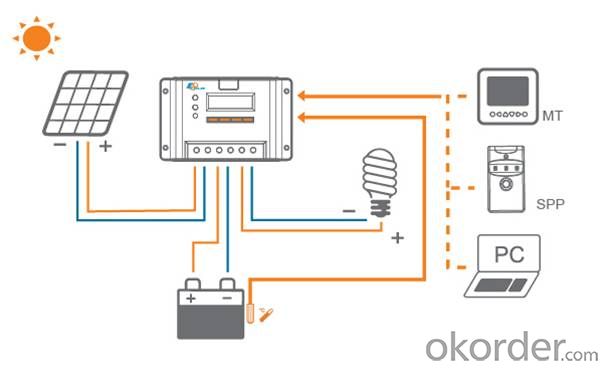
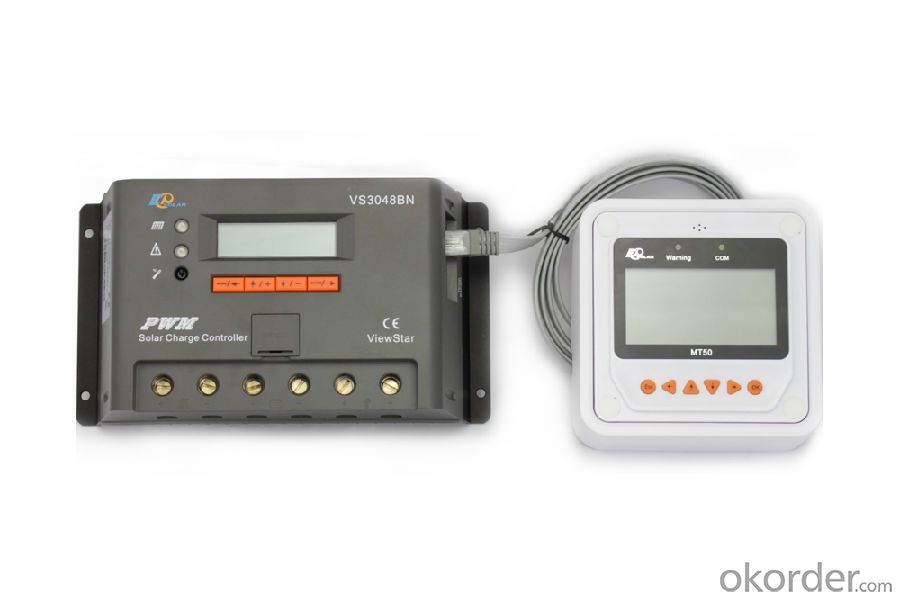
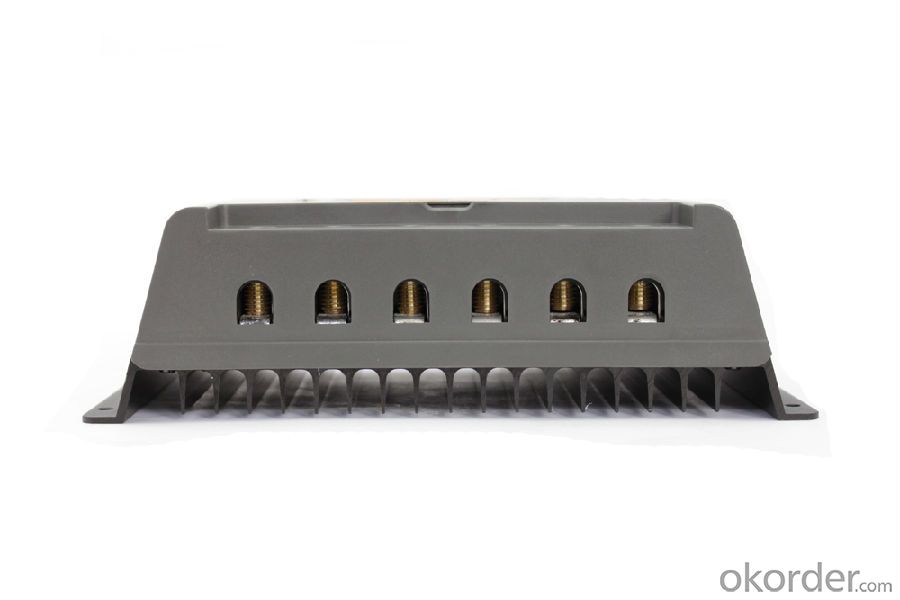
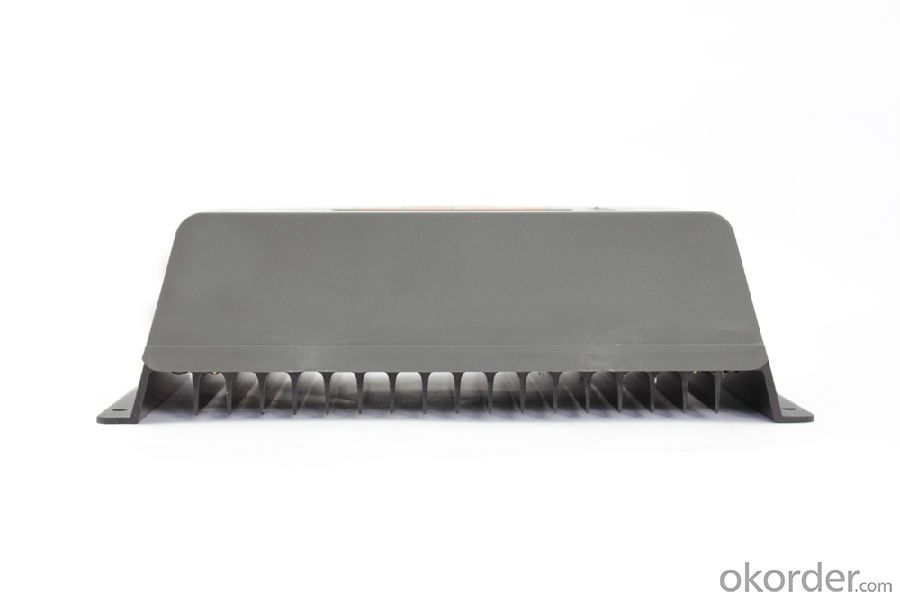
FAQ:
Q1. What is the voltage?
A1. Our 45/60A solar charge controller is 12/24/36/48V auto work.
Q2. What is the difference between MPPT&PWM?
A2. MPPT has higher efficiency, it can track the max power point and won't waste energy.
Q3. What is the efficiency of the MPPT controller?
A3. MPPT>99%, peak conversion efficiency>98%.
Q4. What is the waranty of product?
A4. 12 months.
- Q: Can a solar controller be used in a solar-powered research station in Antarctica?
- Yes, a solar controller can be used in a solar-powered research station in Antarctica. A solar controller regulates and optimizes the charging and discharging of batteries in a solar power system, ensuring efficient energy management. Given the abundant sunlight available in Antarctica during summer months, installing a solar controller would be crucial in maximizing the utilization of solar power and maintaining a stable energy supply for the research station.
- Q: Can a solar controller be used in a solar-powered RV system?
- Yes, a solar controller can be used in a solar-powered RV system. A solar controller is an essential component in a solar-powered system as it regulates and manages the energy flow from the solar panels to the batteries. It ensures that the batteries are charged efficiently and protects them from overcharging or damage. Therefore, using a solar controller in an RV system helps optimize the performance and lifespan of the batteries, making it a crucial component in a solar-powered RV setup.
- Q: Can a solar controller be used with solar panels that are connected to a micro-inverter?
- Yes, a solar controller can be used with solar panels that are connected to a micro-inverter. The solar controller regulates the charging and discharging of the batteries, while the micro-inverter converts the DC power produced by the solar panels into AC power for use in the home or to be fed back into the electrical grid.
- Q: Can a solar controller be used with multiple batteries in parallel?
- Yes, a solar controller can be used with multiple batteries in parallel. The solar controller regulates the charging of the batteries and ensures that they are charged safely and efficiently. When multiple batteries are connected in parallel, the solar controller distributes the charging current evenly among them, ensuring that each battery receives the appropriate charge. This allows for increased capacity and storage capabilities, making it beneficial for solar power systems that require more energy storage.
- Q: Can a solar controller be used with a solar-powered greenhouse system?
- Yes, a solar controller can be used with a solar-powered greenhouse system. A solar controller helps regulate and optimize the charging and discharging of batteries in a solar system, ensuring efficient use of solar energy. In a solar-powered greenhouse system, a solar controller can be used to control the charging of batteries that store excess solar energy, which can then be used to power various greenhouse functions like lighting, ventilation, and irrigation.
- Q: Can a solar controller be used with solar-powered electric vehicles?
- Yes, a solar controller can be used with solar-powered electric vehicles. A solar controller helps regulate and optimize the charging process of a solar panel, ensuring that the maximum power generated is efficiently transferred to the vehicle's battery. This helps maintain the battery's health, improve charging efficiency, and extend the overall range of the vehicle.
- Q: Can a solar controller be used with a solar-powered outdoor entertainment system?
- Yes, a solar controller can be used with a solar-powered outdoor entertainment system. A solar controller helps regulate the charging and discharging of the batteries connected to the solar panels, ensuring efficient and optimal power management. This is essential for maintaining a stable power supply to the outdoor entertainment system, allowing it to operate effectively even in varying sunlight conditions.
- Q: What is the role of a solar controller in preventing damage to the solar panels from hail or storm events?
- The role of a solar controller in preventing damage to solar panels from hail or storm events is primarily to act as a protective mechanism. Hailstorms and severe storms can pose significant risks to solar panels, and a solar controller plays a crucial role in mitigating these risks. Firstly, a solar controller is responsible for monitoring the weather conditions. It can detect the approach of a hailstorm or severe storm by analyzing data from various sensors and weather forecasting systems. This early detection allows the solar controller to initiate precautionary measures before the storm hits. Once a storm is detected, the solar controller can activate protective mechanisms to safeguard the solar panels. One such mechanism is the ability to automatically tilt the panels to an angle that minimizes the surface area exposed to hail or storm winds. This adjustment reduces the chances of hailstones or debris directly hitting the panels, thereby preventing potential damage. Additionally, solar controllers often have built-in sensors that can detect the impact of hailstones on the panels. If the sensors detect a certain level of impact, the controller can automatically shut down the panels to prevent further damage. This feature is crucial as it prevents the panels from generating electricity during a storm, reducing the risk of electrical surges or short circuits. Furthermore, solar controllers can also activate protective coverings or shields to physically shield the panels from hail or storm-induced damage. These coverings are usually made of durable materials that can withstand the impact of hailstones or debris, providing an additional layer of protection to the panels. Overall, the role of a solar controller in preventing damage to solar panels from hail or storm events is to monitor weather conditions, initiate precautionary measures, adjust panel angles, shut down panels if necessary, and provide physical protection. By performing these functions, solar controllers play a crucial role in ensuring the longevity and efficiency of solar panel systems during adverse weather conditions.
- Q: Can a solar controller be used with solar panel ground racks?
- Yes, a solar controller can be used with solar panel ground racks. A solar controller is responsible for regulating the flow of energy from the solar panels to the batteries or electrical loads. It is not directly dependent on the type or location of the solar panel mounting system, so it can be effectively used with ground racks or any other type of solar panel mounting.
- Q: How do I connect solar panels to a solar controller?
- To connect solar panels to a solar controller, follow these steps: 1. Start by positioning your solar panels in a location that receives the maximum amount of sunlight throughout the day. Ensure they are securely mounted and angled properly for optimal sun exposure. 2. Next, locate the positive and negative terminals on your solar panels. These terminals are usually labeled as "+" and "-". Make sure to check the user manual or markings on the panels for accurate identification. 3. Once you have identified the terminals, connect the positive terminal of the first solar panel to the positive input terminal of the solar controller. Use a solar panel cable or wire with appropriate connectors to make a secure connection. Repeat this step for the negative terminals, connecting the negative terminal of the first solar panel to the negative input terminal of the solar controller. 4. If you have multiple solar panels, connect them in series or parallel depending on the solar controller's specifications and your energy needs. Series connections involve connecting the positive terminal of one panel to the negative terminal of the next panel, while parallel connections involve connecting all positive terminals together and all negative terminals together. 5. Once all the solar panels are connected to the solar controller, double-check the connections to ensure they are tight and secure. Loose connections can lead to power loss and inefficiency. 6. Finally, connect the solar controller to your battery bank or power inverter. Most solar controllers have separate terminals for battery connections, labeled as "+" and "-". Connect the positive terminal of the battery to the positive output terminal of the solar controller, and the negative terminal of the battery to the negative output terminal of the solar controller. 7. After completing the connections, power on the solar controller and monitor the charging status. The solar controller will regulate the amount of power flowing from the solar panels to the battery bank, ensuring efficient charging and preventing overcharging. Remember to always consult the user manual provided with your specific solar panels and solar controller for any manufacturer-specific instructions or guidelines.
Send your message to us
LCD Display PWM MPPT Solar System Charge Controller/Regulator 30A 12/24/36/48V, VS3048BN
- Loading Port:
- Tianjin
- Payment Terms:
- TT or LC
- Min Order Qty:
- -
- Supply Capability:
- 10000 pc/month
OKorder Service Pledge
OKorder Financial Service
Similar products
Hot products
Hot Searches
Related keywords
